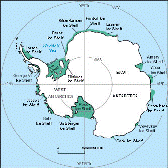Antarctic Drilling Program (ANDRILL)

ANDRILL Related Publications of Affiliates
Document Type
Article
Date of this Version
2007
Abstract
Buried U-shaped troughs as much as 20 km-wide and flat-topped ridges adjacent to western Marie Byrd Land have recently been proposed as the result of late Oligocene West Antarctic glaciation. Here, additional evidence for pre-25 Ma glaciation is presented for the southeast Ross Sea, together with a different stratigraphic correlation path that establishes age constraints. Buried rough glacial topography interpreted to be of Oligocene age contrasts with a buried smooth and planar middle Miocene “Red” angular unconformity. The Red unconformity extends east-west 160 km near the ice shelf edge, and is 700 m-deep. Part of a 2 km section of Oligocene to middle Miocene strata was removed by erosion. Any smooth post-rift subsidence profile requires that the Red unconformity was carved in water depths of several hundred meters. Several early through middle Miocene glacial erosion surfaces merge to form this unconformity, suggesting multiple advances of thick grounded ice.


Comments
Citation: Sorlien, C. C., D. S. Wilson, B. P. Luyendyk, L. R. Bartek, R. C. Decesari, and J. B. Diebold (2007), Buried Oligocene glacial topography beneath a smooth middle Miocene unconformity in the southeast Ross Sea: Evolution of West Antarctic glaciation, in Antarctica: A Keystone in a Changing World – Online Proceedings of the 10th ISAES X, edited by A. K. Cooper and C. R. Raymond et al., USGS Open-File Report 2007-1047, Extended Abstract 099, 4 p.